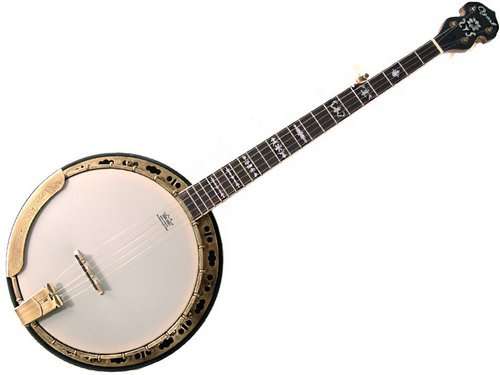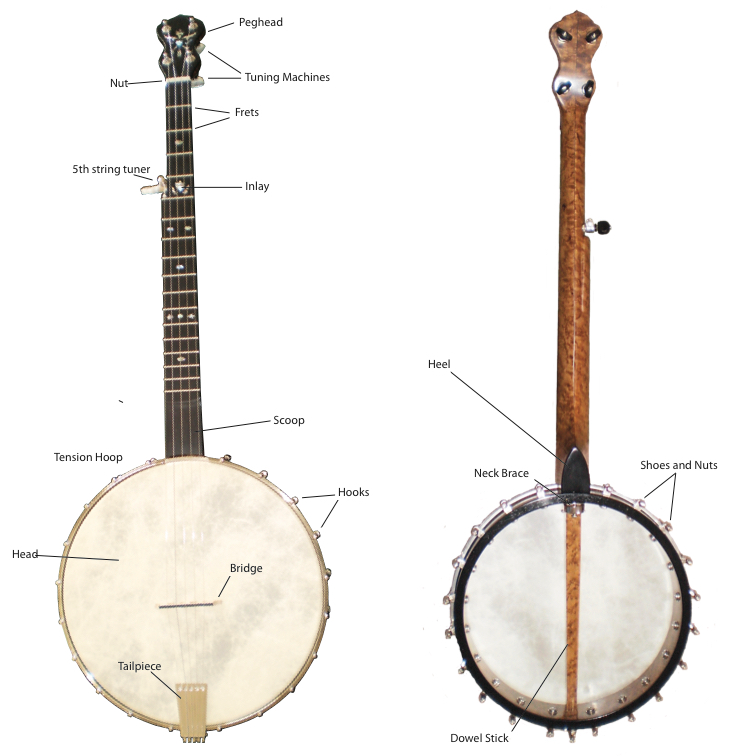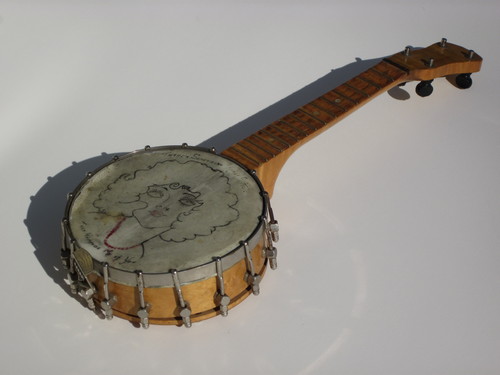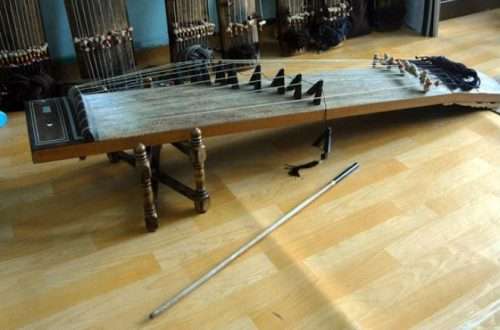
Banjo – string musical instrument
Contents
Banjo – a musical instrument is now very fashionable and in demand, it used to be quite difficult to buy except US, but now it is in every music store. Probably, the point is in a pleasant form, ease of play and a pleasant quiet sound. Many music lovers see their idols in the movies playing the banjo and want to get hold of this wonderful thing too.
In fact , a banjo is a type of guitar that has a rather unusual soundboard – it is a resonator that is stretched over the body, like a drum head. Most often the instrument is associated with Irish music, with blues, with folklore compositions, etc. – the scope is constantly expanding, thanks to the growth in the spread of the banjo.
Traditional american instrument
It is believed that there was no more important instrument for African traditional music in the 19th century; due to its simplicity, it appeared even in the poorest families and many black Americans tried to master it.
Such a tandem is interesting:
violin plus banjo, some experts believe that this combination is classic for “early” American music. There are various options, but most often you can find a 6-string banjo, because it is easy to play after the guitar, but there are varieties with a reduced or vice versa increased number of strings.
Banjo history
The banjo was brought to the Americas by navigators from West Africa around 1600. The mandolin can be considered a relative of the banjo, although researchers will give you about 60 different instruments that are similar to the banjo and may be its predecessors.
The first mention of the banjo is found by the English physician Hans Sloan in 1687. He saw the instrument in Jamaica from African slaves. Their instruments were made from dried gourds covered with leather.

At the beginning of the 19th century in the United States, the banjo seriously competed in popularity with the violin in African American music, then it attracted the attention of white professional musicians, including Joel Walker Sweeney, who popularized the banjo and brought it to the stage in the 1830s. The banjo also owes its external transformation to D. Sweeney: he replaced the pumpkin body with a drum body, demarcated the neck of the neck with frets and left five strings: four long and one short.

The peak of popularity of the banjo falls on the second half to the end of the 19th century, when the banjo can be found at concert venues and among music lovers. At the same time, the first self-instruction manual for playing the banjo was published, performance competitions were held, the first workshops for making instruments were opened, the gut strings were replaced with metal ones, manufacturers experimented with shapes and sizes.
Professional musicians began to perform on stage the works of classics such as Beethoven and Rossini, arranged on the banjo. Also, the banjo has proven itself in such musical styles as ragtime, jazz and blues. And although in the 1930s the banjo was replaced by electric guitars with a brighter sound, in the 40s the banjo again took revenge and returned to the scene.
Currently, the banjo is popular with musicians all over the world, it sounds in various styles of music. Cheerful and sonorous voice of the instrument tunes to the positive and uplifting.

Design features
The design of the banjo is a round acoustic body and a kind of fretboard. The body resembles a drum, on which a membrane is stretched with a steel ring and screws. The membrane can be made of plastic or leather. Plastics are usually used without sputtering or transparent (the thinnest and brightest). The standard head diameter of a modern banjo is 11 inches.

The removable resonator semi-body has a slightly larger diameter than the membrane. The shell of the body is usually made of wood or metal, and the tailpiece is attached to it.
A hyphae is attached to the body with the help of an anchor rod, on which the strings are pulled with the help of pegs. The wooden stand is freely located on the membrane, to which it is pressed by stretched strings.
Just like a guitar, the banjo neck is divided by frets into frets arranged in a chromatic sequence. The most popular banjo has five strings, and the fifth string is shortened and has a special peg located directly on the fretboard, at its fifth fret. This string is played with the thumb and is usually used as a bass string, constantly sounding along with the melody.

Banjo bodies are traditionally made from mahogany or maple. Mahogany provides a softer sound with a predominance of midrange frequencies, while maple will give a brighter sound.
The sound of the banjo is significantly affected by the ring that holds the membrane. There are two main ring pips: flattop, when the head is stretched flush with the rim, and archtop, when the head is raised above the level of the rim. The second type sounds much brighter, which is especially evident in the performance of Irish music.
Blues and country banjo
No need to write off another type of American classic – country – these are incendiary songs with a characteristic sound. Another guitar joins the duet and it turns out a full-fledged trio. It is important that the musicians can exchange instruments, because the playing techniques are very similar, only the sound, which has different resonant and timbre colors, differs fundamentally. It is interesting that some people think that the banjo sounds cheerful and this is its main difference, others, on the contrary, that it is characterized by a sad “blues” sound, it is difficult to argue with this, since opinions are divided and a compromise is not always found.
Banjo strings
Strings are made of metal and less often of plastic (PVC, nylon), special windings are used (steel and non-ferrous metal alloys: copper, brass, etc.), which give the sound a more sonorous and sharp tone. The characteristic sound of a banjo is considered to be the sound of a “tin can”, since the first sensations are such that the strings cling to something and rattle. It turns out that this is a good thing, and many musicians strive to recreate this original “drum guitar” sound in their playing. In the auto industry, there is a banjo bolt, which, according to some reports, is related to music, but in fact, it resembles with its hat (it is connected “tightly” to the washer and has a hole for fixing on a part free from the thread) the design of the drum-deck of the instrument, perhaps that is why it got its name.
Tool design
As already mentioned, the body is not a classic guitar deck, but a kind of drum, a membrane is fixed on the front side (it replaces the resonator hole), it is stretched with a metal ring. This is very similar to the strings of a snare drum. And in fact, this is so: after all, the sound is not external, like that of a guitar or balalaika, domra, but internal, drumming, the membrane rattles – that’s why we get such a unique sound. The ring is fastened with ties – these are specialized screws. It is rare now that a banjo is made of leather, although this material was used in the original, now they use plastic, which is practical and easily replaced if necessary, is cheap.
The string stand is placed directly on the membrane, it determines the height at which the strings will be. The lower they are, the easier it is for the performer to play. The neck is wooden, solid or in parts, attached, like a guitar neck, with a truss rod, with which you can adjust the concavity. The strings are tensioned with pegs using a worm gear.
Types of banjo
The American original banjo has not 6, but 5 strings (it is called blue grass, translated as blue grass), and the bass string is tuned to G and always remains open (it is shortened and does not clamp), you need to get used to this system, although it is quite just after the guitar, since the technique of clamping chords is similar. There are models without a shortened fifth string, these are classic four-string banjos: do, sol, re, la, but the Irish use their own special system, where the salt moves up, so it’s very difficult to understand that they are playing, since the chords are clamped intricately and not at all as the Americans are accustomed to. The six-string banjo is the simplest, it is called the banjo guitar, it has the same tuning, which is why it is especially loved by guitarists. An interesting banjolele instrument that combines ukulele and banjo.
And if there are 8 strings, and 4 are double, then this is a banjo-mandolin.
There is also a popular attraction, the banjo trampoline, which has little to do with music, but is very popular, not recommended for children under 12 because it has some degree of danger. In some countries, it is banned due to accidents, but these are just particulars. The main thing is good insurance and competent use of protective equipment.
Manufacturers’ experiments with the shape and size of the banjo have led to the fact that today there are many types of banjo, which differ, among other things, in the number of strings. But the most popular are the four-, five- and six-string banjos.
- The four-string tenor banjo is a classic. It can be heard in orchestras, solo performance or accompaniment. The neck of such a banjo is shorter than that of a five-string banjo and is most often used for the dixlend. Instrument build – do, salt, re, la. The Irish, unlike the Americans, use their own special tuning, which is characterized by moving the G up, which gives additional intricacy to the squeezed chords. For the performance of Irish music, the banjo system changes to G, D, A, E.

- Five-string banjos are most commonly heard in country or bluegrass music. This type of banjo has a longer neck and simple strings that are shorter than the strings with a tuning key. The shortened fifth string is not clamped, remaining open. The system of this banjo: (sol) re, salt, si, re.

- The six-string banjo is also called the banjo – the guitar, and it is also tuned: mi, la, re, salt, si, mi.

- A banjolele is a banjo that combines a ukulele and a banjo, it has four single strings and is tuned like this: C, G, D, G.

- The banjo mandolin has four double strings tuned like a prima mandolin: G, D, A, E.

Playing Banjo technique
There is no special technique for playing the banjo, it is similar to the guitar. The plucking and striking of the strings is carried out with the help of plectrums worn on the fingers and resembling nails. The musician also uses a mediator or fingers. Almost all types of banjo are played with a characteristic tremolo or arpeggiated with the right hand.

Banjo today
The banjo stands out for its especially sonorous and bright sound, which allows you to stand out from other instruments. Many people associate the banjo with country and bluegrass music. But this is a very narrow perception of this instrument, because it can be found in a variety of musical genres: pop music, Celtic punk, jazz, blues, ragtime, hardcore.
But the banjo can also be heard as a solo concert instrument. Especially for the banjo, such composers-performers as Buck Trent, Ralph Stanley, Steve Martin, Hank Williams, Todd Taylor, Putnam Smith and others composed works. The great works of the classics: Bach, Tchaikovsky, Beethoven, Mozart, Grieg and others have also been transcribed to the banjo.
Today the most famous banja jazzmen are K. Urban, R. Stewart and D. Satriani.
The banjo is widely used in television shows (Sesame Street) and musical performances (Cabaret, Chicago).
Banjos are made by guitar manufacturers, for example. FENDER, CORT, WASHBURN, GIBSON, ARIA, STAGG.

When buying and choosing a banjo, you should proceed from your musical and financial capabilities. Beginners can purchase a four-string or the popular five-string banjo. A professional would recommend a six-string banjo. Also, start from the musical style that you plan to perform.
The banjo is a musical symbol of American culture, like our balalaika, which, by the way, is called the “Russian banjo”.
Banjo FAQ
What does the word Banjo mean?
Banjo (Eng. Banjo) – string pinch musical instrument such as lute or guitar.
How many frets per bandjo?
21
How is Bangjo arranged?
The design of the Bango is a round acoustic case and a kind of vulture. The case resembles a drum on which it is stretched with a steel ring and a membrane.











